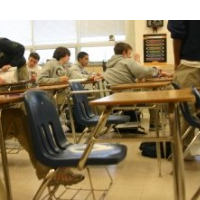American Schoolchildren Absences Up, Suspensions Down

By Jennifer C. Kerr, Associated Press
WASHINGTON (AP) — New government numbers offer a mixed snapshot of progress for the nation's schoolchildren — with worrisome figures on how many students miss school, stubborn disparities on discipline, but encouraging strides in cutting the overall number of suspensions.
The Education Department report found 6.5 million students nationwide were chronically absent in the 2013-14 school year. That's more than one out of every ten students missing at least three full weeks of school. It's the first time the department has collected student absenteeism data.
On a positive note, the survey found a significant drop in school suspensions for K-12 students, down nearly 20 percent from the previous reporting period. But, the report also suggests sharp disparities between how black and white students are disciplined in school as well as the types of advanced coursework offered in high school to black and Latino children.
"A systemic failure to educate some groups of children as well as others tears at the moral fabric of the nation," Education Secretary John B. King Jr., said in a phone call with reporters. "What sets the U.S. apart from any other country is the idea that opportunity is universal. These data show that we still fall far short of that ideal."
Here's a look at the numbers released Tuesday from a biannual survey of all public schools and districts in the country.
CHRONIC ABSENTEEISM
"One of the very worrying data points is that 13 percent of all students are chronically absent," King said in an interview with The AP. "Even the best teacher can't be successful with a student who's not in school."
The rates were higher for high school students. More than 3 million were chronically absent — nearly one in five high school students.
The department defines chronically absent as missing 15 or more days during the school year, increasing their chances of falling behind and dropping out of school.
Black and Latino high school students had about the same rate of absenteeism, 22 percent and 20 percent, respectively. Rates for white students were not provided in the initial release of numbers from the department's Civil Rights Data Collection.
The Obama administration began a program last fall, called Every Student, Every Day, It partners with states and local groups in 30 communities around the country to identify mentors to help students who have been chronically absent get back on track.
SCHOOL DISCIPLINE-THE GOOD NEWS
Across the country, 2.8 million K-12 students received one or more out-of-school suspensions. That's a nearly 20 percent drop from the number reported two years ago.
"A 20 percent reduction, overall, in suspensions is breathtaking," said Catherine E. Lhamon, assistant secretary for civil rights. That's a "tremendous testament to our educators' commitment to making sure the students are in school and can learn."
SCHOOL DISCIPLINE-THE BAD NEWS
Black preschool children are 3.6 times as likely to get one or more out-of-school suspensions as their white counterparts, the report said. Black children represent 19 percent of preschoolers, yet they account for 47 percent of pre-school kids getting one or more suspensions. The comparison to white students: they make up 41 percent of preschoolers, but represent only 28 percent of pre-school children receiving one or more suspensions.
"These disparities beg for more districts to follow the lead of places like Baltimore and Chicago, which are dramatically limiting the use of suspensions in early grades," Lhamon said.
The report also found that 1.6 million students attend a school with a sworn law enforcement officer, but not a school counselor.
COLLEGE-READY COURSEWORK
Nationwide, almost half of high schools offered classes in calculus, and more than three-quarters offered Algebra II. But black and Latino students didn't have the same access to high-level math and science as other students.
According to the report, 33 percent of high schools with substantial black and Latino enrollment offered calculus. That compares to 56 percent of high schools with low numbers black and Latino children that offered calculus. Similar gaps were seen for physics, chemistry and Algebra II.
Inequities were seen in Advanced Placement courses, too. While black and Latino students made up 38 percent of students in schools that offer AP courses, only 29 percent of them were enrolled in at least one AP course.
Associated Press writer Mark S. Smith contributed to this report.
To Learn More:
Truancy, Driven by Low Income and Marked by Racial Divide, Still Costing State Billions (by Ken Broder, AllGov California)
The Real Cost of Truancy in California, $46.4 Billion, Dwarfs Money Lost for Low Attendance (by Ken Broder, AllGov California)
- Top Stories
- Unusual News
- Where is the Money Going?
- Controversies
- U.S. and the World
- Appointments and Resignations
- Latest News
- Musk and Trump Fire Members of Congress
- Trump Calls for Violent Street Demonstrations Against Himself
- Trump Changes Name of Republican Party
- The 2024 Election By the Numbers
- Bashar al-Assad—The Fall of a Rabid AntiSemite






Comments